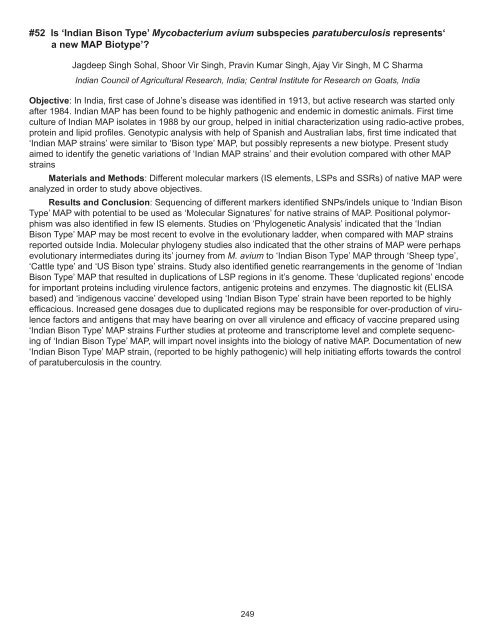Proceedings of the 10th International Colloquium on Paratuberculosis
Proceedings of the 10th International Colloquium on Paratuberculosis
Proceedings of the 10th International Colloquium on Paratuberculosis
Create successful ePaper yourself
Turn your PDF publications into a flip-book with our unique Google optimized e-Paper software.
#52 Is ‘Indian Bis<strong>on</strong> Type’ Mycobacterium avium subspecies paratuberculosis represents‘<br />
a new MAP Biotype’?<br />
Jagdeep Singh Sohal, Shoor Vir Singh, Pravin Kumar Singh, Ajay Vir Singh, M C Sharma<br />
Indian Council <str<strong>on</strong>g>of</str<strong>on</strong>g> Agricultural Research, India; Central Institute for Research <strong>on</strong> Goats, India<br />
Objective: In India, first case <str<strong>on</strong>g>of</str<strong>on</strong>g> Johne’s disease was identified in 1913, but active research was started <strong>on</strong>ly<br />
after 1984. Indian MAP has been found to be highly pathogenic and endemic in domestic animals. First time<br />
culture <str<strong>on</strong>g>of</str<strong>on</strong>g> Indian MAP isolates in 1988 by our group, helped in initial characterizati<strong>on</strong> using radio-active probes,<br />
protein and lipid pr<str<strong>on</strong>g>of</str<strong>on</strong>g>iles. Genotypic analysis with help <str<strong>on</strong>g>of</str<strong>on</strong>g> Spanish and Australian labs, first time indicated that<br />
‘Indian MAP strains’ were similar to ‘Bis<strong>on</strong> type’ MAP, but possibly represents a new biotype. Present study<br />
aimed to identify <str<strong>on</strong>g>the</str<strong>on</strong>g> genetic variati<strong>on</strong>s <str<strong>on</strong>g>of</str<strong>on</strong>g> ‘Indian MAP strains’ and <str<strong>on</strong>g>the</str<strong>on</strong>g>ir evoluti<strong>on</strong> compared with o<str<strong>on</strong>g>the</str<strong>on</strong>g>r MAP<br />
strains<br />
Materials and Methods: Different molecular markers (IS elements, LSPs and SSRs) <str<strong>on</strong>g>of</str<strong>on</strong>g> native MAP were<br />
analyzed in order to study above objectives.<br />
Results and C<strong>on</strong>clusi<strong>on</strong>: Sequencing <str<strong>on</strong>g>of</str<strong>on</strong>g> different markers identified SNPs/indels unique to ‘Indian Bis<strong>on</strong><br />
Type’ MAP with potential to be used as ‘Molecular Signatures’ for native strains <str<strong>on</strong>g>of</str<strong>on</strong>g> MAP. Positi<strong>on</strong>al polymorphism<br />
was also identified in few IS elements. Studies <strong>on</strong> ‘Phylogenetic Analysis’ indicated that <str<strong>on</strong>g>the</str<strong>on</strong>g> ‘Indian<br />
Bis<strong>on</strong> Type’ MAP may be most recent to evolve in <str<strong>on</strong>g>the</str<strong>on</strong>g> evoluti<strong>on</strong>ary ladder, when compared with MAP strains<br />
reported outside India. Molecular phylogeny studies also indicated that <str<strong>on</strong>g>the</str<strong>on</strong>g> o<str<strong>on</strong>g>the</str<strong>on</strong>g>r strains <str<strong>on</strong>g>of</str<strong>on</strong>g> MAP were perhaps<br />
evoluti<strong>on</strong>ary intermediates during its’ journey from M. avium to ‘Indian Bis<strong>on</strong> Type’ MAP through ‘Sheep type’,<br />
‘Cattle type’ and ‘US Bis<strong>on</strong> type’ strains. Study also identified genetic rearrangements in <str<strong>on</strong>g>the</str<strong>on</strong>g> genome <str<strong>on</strong>g>of</str<strong>on</strong>g> ‘Indian<br />
Bis<strong>on</strong> Type’ MAP that resulted in duplicati<strong>on</strong>s <str<strong>on</strong>g>of</str<strong>on</strong>g> LSP regi<strong>on</strong>s in it’s genome. These ‘duplicated regi<strong>on</strong>s’ encode<br />
for important proteins including virulence factors, antigenic proteins and enzymes. The diagnostic kit (ELISA<br />
based) and ‘indigenous vaccine’ developed using ‘Indian Bis<strong>on</strong> Type’ strain have been reported to be highly<br />
efficacious. Increased gene dosages due to duplicated regi<strong>on</strong>s may be resp<strong>on</strong>sible for over-producti<strong>on</strong> <str<strong>on</strong>g>of</str<strong>on</strong>g> virulence<br />
factors and antigens that may have bearing <strong>on</strong> over all virulence and efficacy <str<strong>on</strong>g>of</str<strong>on</strong>g> vaccine prepared using<br />
‘Indian Bis<strong>on</strong> Type’ MAP strains Fur<str<strong>on</strong>g>the</str<strong>on</strong>g>r studies at proteome and transcriptome level and complete sequencing<br />
<str<strong>on</strong>g>of</str<strong>on</strong>g> ‘Indian Bis<strong>on</strong> Type’ MAP, will impart novel insights into <str<strong>on</strong>g>the</str<strong>on</strong>g> biology <str<strong>on</strong>g>of</str<strong>on</strong>g> native MAP. Documentati<strong>on</strong> <str<strong>on</strong>g>of</str<strong>on</strong>g> new<br />
‘Indian Bis<strong>on</strong> Type’ MAP strain, (reported to be highly pathogenic) will help initiating efforts towards <str<strong>on</strong>g>the</str<strong>on</strong>g> c<strong>on</strong>trol<br />
<str<strong>on</strong>g>of</str<strong>on</strong>g> paratuberculosis in <str<strong>on</strong>g>the</str<strong>on</strong>g> country.<br />
249






